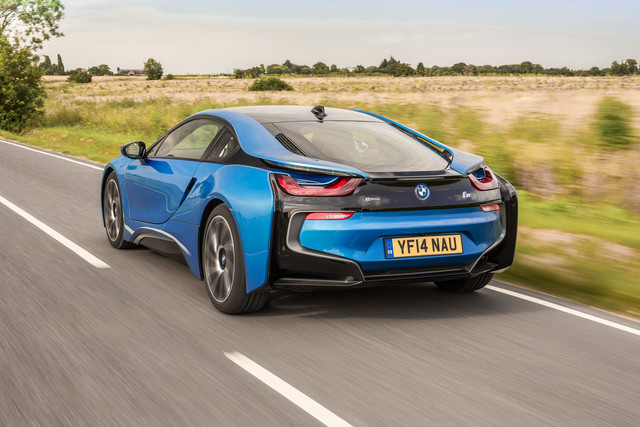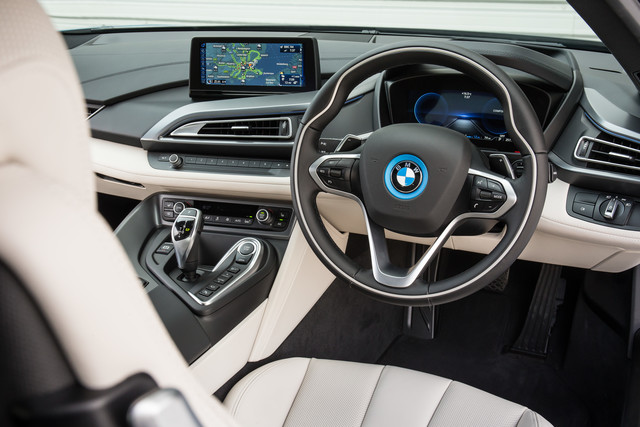If there is a more effective way of spending £104,540 to make new friends than buying a BMW i8, I've yet to hear of it. No doubt there will come a day when this is just another hybrid sports car among so many, and people will chat about its technical features the way they might about the price of milk, but for now it's a fascinating, slightly mysterious machine whose owners will be bombarded with questions by interested onlookers.
The rear axle is powered by a 1.5-litre turbo petrol engine, the front by an electric motor. In combination, they produce up to 357bhp, which is enough to give the car a 0-62mph time of 4.4 seconds and oblige BMW to limit the top speed to 155mph. The acceleration is, if not exactly brutal, certainly attention-grabbing, and from the inside the engine sounds fantastic when it's being given the full beans.
Not so from the outside. A friend who missed his chance to take a picture of the test car when it was being driven past him flat-out because he didn't hear it coming was astonished, when I gave him a lift later that day, at the interior noise levels. This is a piece of trickery designed to give occupants more of a thrill than they would otherwise experience, but the sound (which my friend compared to that of a Nissan GT-R) is stirring, and doesn't seem nearly as artificial as it actually is.
 On balance, the i8 is better in a straight line than it is through corners. Low-profile tyres make the ride firm in some ways, but the suspension set-up is soft, and those same tyres are relatively narrow (215mm at the front, 245mm at the rear) and made of hard-compound rubber. In very hard cornering it's easy to set off the Dynamic Stability Control, which can be switched off but probably ought not to be.
On balance, the i8 is better in a straight line than it is through corners. Low-profile tyres make the ride firm in some ways, but the suspension set-up is soft, and those same tyres are relatively narrow (215mm at the front, 245mm at the rear) and made of hard-compound rubber. In very hard cornering it's easy to set off the Dynamic Stability Control, which can be switched off but probably ought not to be.
There is also a sense that the i8 is made from the front half of one car and the rear of another one altogether. You notice this when you floor the accelerator on the way out of a corner and feel the two motors reacting in different ways at different times. It's unlikely that you will feel this effect on public roads (unless you happen to be a dangerous lunatic, which I'm sure you're not) but it would be very evident on a trackday.
The exterior design, by contrast, is definitely all of a piece, and perhaps the single most impressive thing about the i8. Everyone I've discussed this with thinks it's beautiful, and many of its features are more than just for show. One panel, for example, starts out as part of the roof but becomes both a rear wing and the top part of a channel which appears to be intended to send air into the low-pressure area behind the car. That would reduce drag and, like the narrow tyres, contribute to what on paper are spectacular fuel economy and CO2 figures.
How do 134.5mpg and 49g/km grab you? Quite tightly, I imagine. But that's on the EU test, when the car starts out with a fully charged battery and is never required to perform anything like as strongly as it can. The first thing I did with the test car was drive it the length of the M40 at moderate speeds in ECO PRO mode, and I averaged 38mpg. That's pretty good for something that looks like a supercar, of course, but not even within hailing distance of 134.5.
Still, the official CO2 figure applies no matter how much of the stuff the car actually emits, so you don't have to worry about Vehicle Excise Duty, you won't have to pay the London congestion charge and, where applicable, Benefit In Kind taxation is minuscule.
 You weren't going to buy an i8 for its practicality, were you? Just as well. The main luggage compartment, mounted behind the engine, has a capacity of just 154 litres, and there are very few storage spaces inside - unless you count the rear passenger area, which is so cramped that hardly anyone could possibly sit there.
You weren't going to buy an i8 for its practicality, were you? Just as well. The main luggage compartment, mounted behind the engine, has a capacity of just 154 litres, and there are very few storage spaces inside - unless you count the rear passenger area, which is so cramped that hardly anyone could possibly sit there.
There's plenty of room for tall fellows up front, though, and the interior design is lovely. Getting in there is also interesting, as the i8 has gullwing doors which open up more than out. That's handy for access in tight spaces, and you soon get used to entering hindquarters first and pulling your legs in afterwards. Quite how you're supposed to get back out if the car lands on its roof is another matter, and frankly not one I wanted to devote much thought to until after this test was over.



